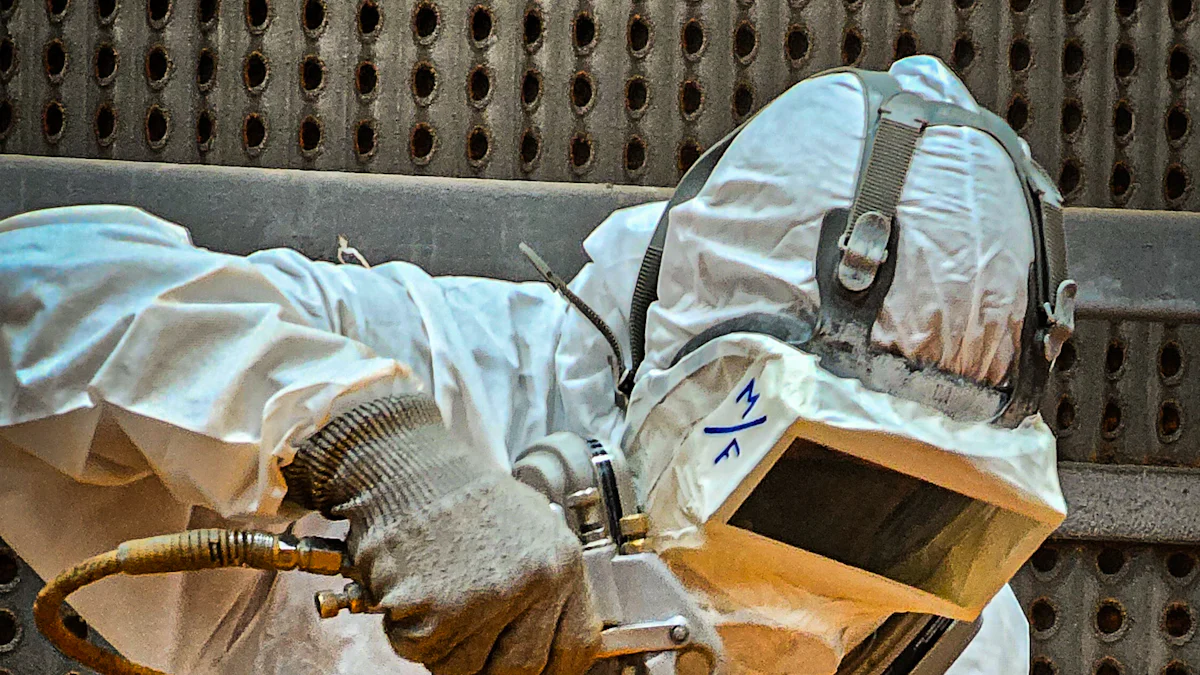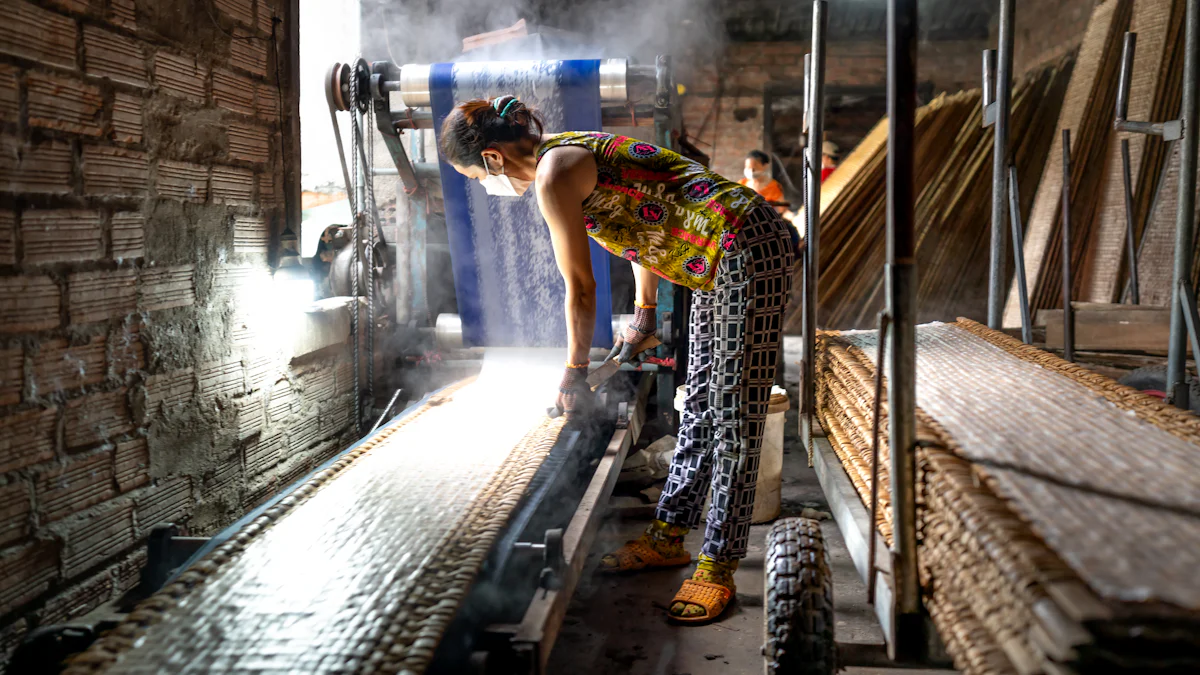Sandblasting Explained: Basics and Applications

Sand blasting revolutionized surface treatment by using abrasive materials propelled at high speed to clean, smooth, or shape surfaces. This method, patented in 1870 by Benjamin Chew Tilghman, became a cornerstone for industries needing efficient surface preparation. You can rely on sand blasting to remove rust, paint, or corrosion residue, ensuring surfaces are ready for restoration or coating. Its versatility extends to cleaning boat hulls, brick, and concrete structures. From industrial applications to artistic etching, sand blasting remains an essential tool for altering and enhancing surface conditions.
The Basics of Sandblasting

What is Sandblasting?
Definition and key characteristics
Sandblasting is a surface processing method that uses high-speed abrasive particles to clean, shape, or smooth surfaces. This technique relies on the force of compressed air or water to propel abrasive materials against a surface. The process effectively removes contaminants like rust, paint, or debris, leaving the surface clean and ready for further treatment. Sandblasting is widely recognized for its ability to enhance surface adhesion, making it an essential step in many industrial and artistic applications.
The choice of abrasive material plays a crucial role in determining the outcome. Harder abrasives like steel grit are ideal for heavy-duty cleaning, while softer options like glass beads provide a smoother finish. This flexibility allows sandblasting to cater to various industries, from automotive restoration to decorative etching.
How sandblasting works: The basic process
The sandblasting process begins with the selection of the appropriate abrasive material and equipment. Compressed air or water generates the force needed to propel the abrasive particles through a nozzle. When these particles strike the surface, they remove unwanted layers, such as rust or old paint, and create a desired texture.
The effectiveness of sandblasting depends on several factors:
Abrasive type: Materials like sand, glass beads, or baking soda offer different levels of abrasiveness.
Particle size: Smaller particles create finer finishes, while larger ones handle tougher cleaning tasks.
Pressure settings: Higher pressure increases the impact force, making it suitable for harder surfaces.
By adjusting these parameters, you can achieve precise results tailored to your specific needs.
Key Components of Sandblasting Equipment
Abrasive materials: Sand, glass beads, and more
The choice of abrasive material significantly impacts the sandblasting process. Common abrasives include:
Sand: A traditional option, effective for general cleaning and surface preparation.
Glass beads: Ideal for achieving a smooth, polished finish without damaging delicate surfaces.
Steel grit: Perfect for heavy-duty cleaning tasks, such as removing rust or tough coatings.
Baking soda: A gentle abrasive used in applications requiring minimal surface damage, like cleaning soft metals or delicate surfaces.
Each abrasive has unique properties that make it suitable for specific tasks. For example, glass beads are often used in wet vapor blasting cabinets to minimize dust and achieve a refined finish.
Tools and machinery: Compressors, nozzles, and safety gear
Industrial sandblasting equipment consists of several key components that work together to deliver efficient results:
Air compressors: These generate the high-pressure air needed to propel the abrasive material.
Nozzles: These control the flow and direction of the abrasive particles. Different nozzle sizes and shapes allow for varying levels of precision.
Abrasive blast machinery: This includes the containment systems, such as hoppers or cabinets, that store and direct the abrasive material.
Safety gear: Essential for protecting operators from dust and debris. This includes respirators, gloves, goggles, and protective suits.
Proper maintenance of these tools ensures consistent performance and extends their lifespan. Regularly inspecting and replacing worn-out components, such as nozzles, helps maintain efficiency and safety.
Types of Sandblasting Methods
Dry Sandblasting
Overview and common uses
Dry sandblasting is one of the most widely used methods in surface treatment. It involves propelling abrasive particles at high speed using compressed air. This method effectively removes rust, paint, and other contaminants from surfaces. You can rely on dry sandblasting for tasks like preparing metal surfaces for painting or coating. It also works well for cleaning machinery, tools, and industrial equipment.
This method is particularly popular in industries where dust control is not a primary concern. For example, construction sites and manufacturing facilities often use dry sandblasting to clean and restore surfaces. Its ability to handle tough cleaning tasks makes it a go-to choice for heavy-duty applications.
Advantages and limitations
Dry sandblasting offers several advantages:
Efficiency: It quickly removes contaminants and prepares surfaces for further treatment.
Versatility: You can use it on various materials, including metal, concrete, and wood.
Cost-effectiveness: The equipment and abrasives are relatively affordable.
However, this method has limitations. The process generates a significant amount of dust, which can pose health risks and environmental concerns. You must use proper safety gear and ensure adequate ventilation to minimize these risks. Additionally, dry sandblasting may not be suitable for delicate surfaces, as the high-speed abrasives can cause damage.
Wet Sandblasting
How it differs from dry sandblasting
Wet sandblasting uses water along with abrasive materials, unlike its dry counterpart. The addition of water reduces dust generation, making it a safer and cleaner option. This method is ideal for environments where dust control is essential, such as indoor spaces or areas near sensitive equipment.
The water also acts as a cooling agent, which helps prevent heat buildup on the surface being treated. This feature makes wet sandblasting suitable for delicate materials that could warp or crack under high temperatures.
Applications in delicate or dust-sensitive environments
Wet sandblasting excels in applications requiring minimal dust. You can use it to clean surfaces in hospitals, laboratories, or food processing facilities where cleanliness is critical. It is also effective for restoring delicate surfaces, such as antique furniture or soft metals, without causing damage.
This method is commonly used in automotive restoration to remove paint or rust without harming the underlying metal. Additionally, wet sandblasting works well for cleaning graffiti from walls or restoring historical monuments.
Bead Blasting
Use of glass beads for a smoother finish
Bead blasting uses glass beads as the abrasive material. These beads are less aggressive than traditional abrasives, making them ideal for achieving a smooth and polished finish. The process involves propelling the beads at high speed to clean or texture surfaces without causing significant wear.
You can use bead blasting to remove surface imperfections, such as scratches or tool marks, while maintaining the integrity of the material. This method is particularly effective for creating a uniform appearance on metal surfaces.
Applications in automotive and decorative industries
Bead blasting is widely used in the automotive industry. It helps restore car parts, such as engine components or wheels, by removing rust and grime while preserving the original shape. This method is also popular in decorative applications, where it creates textured finishes on glass, metal, or ceramic surfaces.
For example, you can use bead blasting to etch intricate designs on glassware or add a matte finish to stainless steel fixtures. Its ability to deliver precise and aesthetically pleasing results makes it a favorite in both industrial and artistic settings.
Soda Blasting
Use of baking soda for gentle cleaning
Soda blasting uses baking soda as the primary abrasive material. This method stands out for its gentle cleaning capabilities, making it ideal for delicate surfaces. Baking soda particles are soft yet effective, allowing you to remove contaminants without damaging the underlying material. The process works well for cleaning surfaces like soft metals, glass, or even wood.
Unlike harsher abrasives, baking soda does not leave scratches or alter the surface texture. It also neutralizes acidic residues, which can be beneficial in certain cleaning applications. For example, you can use soda blasting to clean engine parts, as it removes grease and grime while preserving the integrity of the components.
Applications in restoration and cleaning
Soda blasting excels in restoration projects. You can use it to remove paint, soot, or mold from historical structures without harming the original material. This method is also effective for cleaning delicate items, such as antique furniture or sculptures. Its non-destructive nature makes it a preferred choice for professionals working on valuable or fragile objects.
In industrial settings, soda blasting helps clean machinery and equipment. It removes contaminants like oil or carbon deposits, ensuring optimal performance. Additionally, this method is environmentally friendly, as baking soda is biodegradable and non-toxic. You can rely on soda blasting for tasks that require precision and care.
Shot Blasting
Use of steel shots for heavy-duty cleaning
Shot blasting employs steel shots or grit as the abrasive material. This method is designed for heavy-duty cleaning tasks, where you need to remove tough contaminants like rust, scale, or old coatings. Steel shots are highly durable and reusable, making them a cost-effective option for industrial applications.
The process involves propelling steel shots at high speed onto a surface. The impact removes unwanted layers and creates a uniform texture. Shot blasting is particularly effective for preparing metal surfaces before painting or coating. It ensures better adhesion and extends the lifespan of the applied finish.
Expert Insight: "If done properly, sandblasting becomes one of the most efficient ways to eradicate rust," says Shot Blasting Experts, specialists in surface preparation and rust removal.
Applications in industrial and manufacturing settings
Shot blasting plays a crucial role in industrial and manufacturing environments. You can use it to clean and prepare large metal structures, such as bridges, pipelines, or storage tanks. It is also widely used in the automotive and aerospace industries for treating engine components, gears, and other metal parts.
This method enhances the durability and performance of materials by removing impurities and creating a smooth, clean surface. Additionally, shot blasting helps in shaping and strengthening metal parts through a process known as peening. Its efficiency and reliability make it indispensable in heavy industries.
Hydro-Blasting
Use of high-pressure water for cleaning
Hydro-blasting, also known as water blasting, uses high-pressure water jets to clean surfaces. This method eliminates the need for abrasive materials, relying solely on the force of water to remove contaminants. It is an excellent choice for tasks requiring minimal dust and debris.
The high-pressure water effectively removes dirt, paint, or rust without damaging the surface. Hydro-blasting also prevents heat buildup, making it suitable for materials sensitive to high temperatures. You can adjust the water pressure to achieve the desired level of cleaning, ensuring precision and control.
Applications in environments requiring minimal dust
Hydro-blasting is ideal for environments where dust control is critical. You can use it in food processing facilities, hospitals, or laboratories to clean equipment and surfaces without introducing harmful particles. It is also effective for cleaning tanks, pipes, and other confined spaces where traditional methods may not be feasible.
This method works well for restoring concrete, brick, or stone structures. It removes grime and stains while preserving the original appearance. Hydro-blasting is also a popular choice for removing graffiti or cleaning outdoor surfaces, as it minimizes environmental impact and ensures a clean, dust-free workspace.
Safety Note: According to Sandblasting Specialists, ensuring a safe working environment is essential when using industrial sandblasting equipment or hydro-blasting tools. Proper training and protective gear are crucial for operator safety.
Applications of Sandblasting Across Industries

Sandblasting has proven to be a versatile and effective technique across various industries. Its ability to clean, shape, and prepare surfaces makes it indispensable for professionals in fields ranging from automotive repair to construction. Below, you will discover how sandblasting transforms processes in key industries.
Automotive Industry
Paint removal and surface preparation
In the automotive industry, sandblasting plays a critical role in preparing vehicles for restoration or repainting. You can use this method to strip old paint layers efficiently, ensuring a clean and smooth surface for new coatings. By removing contaminants like rust and dirt, sandblasting enhances the adhesion of paint, resulting in a durable and flawless finish. This process is especially valuable when restoring vintage cars or repairing damaged vehicle parts.
Pro Tip: Use softer abrasives like glass beads for delicate car panels to avoid surface damage during paint stripping.
Restoration of old or rusted parts
Rust removal is another essential application of sandblasting in automotive work. You can rely on this technique to eliminate corrosion from metal components, such as engine parts, wheels, or chassis. Sandblasting not only restores the original appearance of these parts but also extends their lifespan by preventing further deterioration. For heavy-duty rust removal, shot blasting with steel grit offers exceptional results, making it a preferred choice for industrial-grade cleaning.
Construction and Building Maintenance
Cleaning and restoring concrete, brick, and stone
Sandblasting excels in cleaning and restoring building materials like concrete, brick, and stone. You can use it to remove grime, graffiti, or weather stains from surfaces, bringing back their original appearance. This method is particularly effective for historical restoration projects, where preserving the integrity of the material is crucial. Wet sandblasting is often recommended for these tasks, as it minimizes dust and prevents damage to delicate structures.
Did You Know? Sandblasting can also remove oxide scale from metal reinforcements in concrete, improving structural integrity.
Surface preparation for painting or coating
Before applying paint or protective coatings, proper surface preparation is essential. Sandblasting creates a rough texture on smooth surfaces, allowing coatings to adhere more effectively. You can achieve consistent results on materials like steel beams, walls, or floors. This process ensures that the paint or coating lasts longer, reducing maintenance costs over time. For large-scale construction projects, sandblasting saves time and delivers professional-grade results.
Manufacturing and Industrial Use
Smoothing and shaping metal parts
In manufacturing, sandblasting serves as a reliable method for smoothing and shaping metal parts. You can use it to remove imperfections like casting marks, scratches, or burrs, ensuring a polished and uniform finish. This process is vital for producing high-quality components used in machinery, tools, or consumer products. Bead blasting, which uses glass beads, is particularly effective for achieving a smooth surface without compromising the material's integrity.
Removing contaminants or coatings
Industrial facilities often rely on sandblasting for cleaning equipment and machinery. You can use it to remove contaminants like grease, oil, or old coatings, ensuring optimal performance and safety. Shot blasting is a popular choice for heavy-duty cleaning tasks, such as oxide scale removal from metal surfaces. This method not only cleans but also strengthens the material through a process called peening, making it more resistant to wear and tear.
Expert Insight: "Sandblasting remains one of the most efficient methods for preparing surfaces in industrial settings," says a leading surface preparation specialist.
Artistic and Decorative Applications
Etching designs on glass or metal
Sandblasting offers a precise and creative way to etch intricate designs onto glass or metal surfaces. By directing a controlled stream of abrasive material, you can carve patterns, logos, or text into these surfaces with remarkable accuracy. This technique allows you to achieve a frosted or textured effect, enhancing the visual appeal of the material.
For glass, sandblasting creates stunning decorative pieces like etched windows, mirrors, or glassware. You can use it to personalize items such as wine glasses or awards, making them unique and memorable. On metal, this method is ideal for engraving plaques, nameplates, or decorative panels. The etched designs not only add aesthetic value but also provide a durable finish that resists wear over time.
Fun Fact: Sandblasting is a preferred method for creating custom designs on trophies and commemorative items due to its precision and ability to handle delicate materials.
Creating textured finishes on surfaces
Sandblasting excels in creating textured finishes that enhance the look and feel of various surfaces. By adjusting the abrasive material and pressure, you can achieve a range of textures, from subtle matte finishes to bold, rugged patterns. This versatility makes it a popular choice for both functional and decorative purposes.
In interior design, you can use sandblasting to add texture to walls, tiles, or furniture, giving spaces a unique and modern touch. For outdoor applications, it works well on stone or concrete surfaces, creating slip-resistant finishes for walkways or patios. Artists and designers often rely on this technique to bring their creative visions to life, whether through sculptural elements or architectural details.
Pro Tip: Experimenting with different abrasives, such as glass beads or aluminum oxide, can help you achieve the desired texture and finish for your project.
Sandblasting applications in artistic and decorative fields demonstrate its ability to combine functionality with creativity. Whether you aim to etch detailed designs or craft textured finishes, this technique offers endless possibilities for transforming ordinary surfaces into extraordinary works of art.
Advantages and Disadvantages of Sandblasting
Advantages
Efficiency in cleaning and surface preparation
Sandblasting stands out as one of the most efficient methods for cleaning and preparing surfaces. You can rely on it to quickly remove paint, rust, corrosion, and other contaminants from a variety of materials. This speed and effectiveness make it an essential tool in industries like construction, automotive, and manufacturing. By using sandblasting, you save time and effort compared to manual cleaning methods, ensuring surfaces are ready for painting, coating, or restoration in a fraction of the time.
Fact: Sandblasting technology has become a preferred choice for surface preparation due to its ability to handle tough cleaning tasks with precision.
Versatility across materials and industries
The versatility of sandblasting allows you to work with a wide range of materials, including metal, concrete, wood, and glass. Whether you need to clean industrial equipment, restore historical structures, or etch intricate designs on glass, sandblasting adapts to your needs. Its applications span multiple industries, from heavy-duty tasks like shot blasting in manufacturing to delicate cleaning processes in artistic and decorative projects. This adaptability ensures that sandblasting remains a valuable tool for professionals across various fields.
Ability to achieve precise and detailed results
Sandblasting offers unmatched precision, enabling you to achieve detailed results even on complex surfaces. By adjusting the abrasive material, pressure, and nozzle type, you can control the level of cleaning or texturing. This precision makes sandblasting ideal for tasks like etching designs on glass or preparing intricate metal parts for assembly. You can trust this method to deliver consistent and high-quality results, whether you're working on large-scale industrial projects or small artistic endeavors.
Disadvantages
Potential health and safety risks
Despite its efficiency, sandblasting poses significant health and safety risks if not handled properly. The process generates dust and airborne particles, which can harm your respiratory system when inhaled. Prolonged exposure to these particles may lead to serious health issues, such as silicosis. To mitigate these risks, you must wear protective gear, including respirators, gloves, and goggles, and ensure proper ventilation in your workspace. Neglecting safety protocols can result in hazardous situations for operators.
Safety Tip: Always follow safety guidelines and use the necessary equipment to protect yourself from the risks associated with sandblasting.
Environmental concerns, such as dust and waste
Sandblasting can have adverse effects on the environment due to the dust and waste it produces. Abrasive materials, when propelled at high speeds, create fine particles that can contaminate the air and surrounding areas. These particles may also pose a risk to nearby ecosystems. To minimize environmental impact, you should consider using eco-friendly abrasives and containment systems that reduce dust generation. Wet sandblasting is another option that helps control dust and makes the process cleaner.
Limitations with certain materials or delicate surfaces
While sandblasting is versatile, it may not be suitable for all materials or surfaces. Delicate items, such as soft metals, antique furniture, or thin glass, can sustain damage from the high-speed abrasives. In such cases, gentler methods like soda blasting or wet sandblasting provide better alternatives. You must carefully assess the material and choose the appropriate technique to avoid unintended damage. This limitation highlights the importance of understanding the specific requirements of each project.
Safety Considerations in Sandblasting
Importance of Protective Gear
Respirators, gloves, and eye protection
When you engage in sandblasting, protecting yourself from harmful particles becomes essential. The process generates fine dust and debris that can harm your respiratory system and skin. You should always wear a high-quality respirator to prevent inhaling airborne particles. Look for respirators rated for silica dust or other hazardous materials commonly encountered during sandblasting.
Protective gloves shield your hands from abrasives and sharp debris. Choose gloves made from durable materials like leather or rubber for maximum safety. Eye protection is equally critical. Flying particles can cause severe eye injuries, so you must wear goggles or a full-face shield. These items ensure your safety while allowing you to focus on the task at hand.
Safety Expert Insight: "Appropriate personal protective equipment (PPE) includes respiratory protection, protective clothing, and eye and face protection. Neglecting these can lead to serious injuries," advises a safety expert.
Ensuring proper ventilation
Proper ventilation plays a vital role in maintaining a safe workspace. Sandblasting produces dust and fumes that can accumulate quickly in enclosed areas. You should work in well-ventilated spaces or use exhaust systems to remove airborne contaminants. If you operate in confined spaces, portable ventilation units can help maintain air quality. This step reduces health risks and ensures a safer environment for everyone involved.
Environmental Safety
Managing dust and waste
Sandblasting generates significant amounts of dust and waste, which can harm the environment if not managed properly. You should use containment systems, such as blast cabinets or tarps, to capture debris and prevent it from spreading. After completing the job, collect and dispose of waste materials according to local regulations. Proper waste management not only protects the environment but also keeps your workspace clean and organized.
Pro Tip: Wet sandblasting can help reduce dust generation, making it a cleaner and safer option for certain projects.
Using eco-friendly abrasive materials
The choice of abrasive material impacts both the environment and the quality of your work. Opt for eco-friendly abrasives like crushed glass, garnet, or baking soda. These materials are biodegradable and less harmful to the environment compared to traditional sand. By selecting sustainable options, you minimize your ecological footprint while achieving excellent results.
Training and Best Practices
Importance of operator training
Competency training is non-negotiable when it comes to sandblasting. You must understand the health risks, proper use of equipment, and safe operating techniques. Enroll in training programs that cover these aspects comprehensively. Certified operators are better equipped to handle challenges and maintain a safe working environment. Ongoing education ensures you stay updated on the latest safety protocols and industry standards.
Expert Advice: "Training programs should cover the health risks associated with sandblasting, the correct use of PPE, and safe operating techniques," emphasizes a safety expert.
Regular maintenance of equipment
Maintaining your equipment is just as important as using it correctly. Inspect tools like nozzles, compressors, and hoses regularly for wear and tear. Replace damaged components immediately to avoid accidents or inefficiencies. Proper maintenance extends the lifespan of your equipment and ensures consistent performance. A well-maintained setup not only enhances safety but also improves the quality of your work.
By prioritizing safety considerations, you protect yourself, others, and the environment while achieving professional results in sandblasting.
Sandblasting offers you an efficient and versatile solution for surface preparation, cleaning, and finishing. By understanding its various methods, such as dry, wet, and soda blasting, you can select the right approach for your specific needs. This technique plays a vital role in industries like construction, automotive, and art, delivering high-quality results at a low cost. While it provides numerous benefits, recognizing its limitations ensures safe and effective use. Sandblasting remains an indispensable tool, empowering you to achieve precision and durability across countless applications.
FAQ
What is sandblasting?
Sandblasting is a surface treatment method that uses abrasive materials propelled at high speed to clean, smooth, or shape surfaces. You can use it to even out a surface and prepare it for coatings like paint or protective layers. This process ensures better adhesion and enhances the durability of the applied finish.
Is sandblasting safe to use on all materials?
No, sandblasting is not suitable for all materials. While it works well on metals, concrete, and stone, it may damage delicate surfaces like thin glass, soft metals, or antique furniture. For fragile materials, you should consider gentler methods like soda blasting or wet sandblasting to avoid unintended damage.
What types of abrasives are used in sandblasting?
Sandblasting uses a variety of abrasives depending on the task. Common options include:
Sand: Ideal for general cleaning and surface preparation.
Glass beads: Perfect for achieving a smooth, polished finish.
Steel grit: Best for heavy-duty cleaning tasks like rust removal.
Baking soda: Gentle enough for delicate surfaces.
Each abrasive offers unique benefits, so you should choose one based on the material and desired outcome.
Can I perform sandblasting at home?
Yes, you can perform sandblasting at home, but it requires proper equipment and safety precautions. You need an air compressor, a blasting nozzle, and protective gear like respirators, gloves, and goggles. Ensure you work in a well-ventilated area or use containment systems to manage dust and debris. If you're new to sandblasting, start with small projects to gain experience.
How does wet sandblasting differ from dry sandblasting?
Wet sandblasting uses water along with abrasive materials, while dry sandblasting relies solely on compressed air. The addition of water in wet sandblasting reduces dust, making it a cleaner and safer option. Wet sandblasting is ideal for environments where dust control is essential, such as indoor spaces or areas near sensitive equipment.
What industries benefit the most from sandblasting?
Sandblasting is widely used across various industries, including:
Automotive: For paint removal and rust restoration.
Construction: To clean and restore concrete, brick, and stone.
Manufacturing: For smoothing and shaping metal parts.
Artistic applications: To etch designs on glass or metal.
Its versatility makes it an indispensable tool for professionals in these fields.
What safety precautions should I take when sandblasting?
When sandblasting, you must prioritize safety. Wear protective gear, including a respirator, gloves, goggles, and a protective suit. Work in a well-ventilated area or use exhaust systems to remove airborne particles. Regularly inspect your equipment for wear and tear to prevent accidents. Proper training is also essential to ensure safe operation.
Does sandblasting harm the environment?
Sandblasting can impact the environment if not managed properly. Dust and waste generated during the process may contaminate the air and surrounding areas. To minimize environmental harm, use eco-friendly abrasives like crushed glass or baking soda. Wet sandblasting is another option that reduces dust and makes the process cleaner.
How do I choose the right sandblasting method?
To choose the right sandblasting method, consider the material, the desired finish, and the environment. For heavy-duty cleaning, dry sandblasting or shot blasting works best. For delicate surfaces, opt for soda blasting or wet sandblasting. Assess your project requirements and select the method that aligns with your goals.
Can sandblasting be used for artistic purposes?
Yes, sandblasting is a popular technique for artistic applications. You can use it to etch intricate designs on glass, metal, or ceramic surfaces. It also creates textured finishes that enhance the aesthetic appeal of various materials. Artists and designers often rely on sandblasting to bring creative visions to life with precision and detail.
See Also
How to Determine the Best Die Casting Closing Force for Your Product
Understanding Functional Testing in CNC and Die Casting
Seven Essential Steps to Collaborate with a Global Diecast Factory
Defining MOQ and Its Effects on RFQs
Exploring QFD, FMEA, and DOE's Impact on Quality
About Hunan Puka
Established in 2016 and based in Hunan, China, with a liaison point in Berlin, we are a Tier 2 supplier for the automobile industry. We specialize in the production of customized aluminum die-casting parts designed for machines with a closing force ranging from 280 to 800 tons, with subsequent manufacturing process CNC machining and surface treatment. Our commitment to quality is reflected in our accredited quality management system, certified by ISO9001:2015 and IATF16949:2016 standards.


